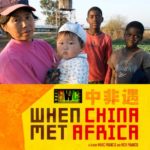Up the Yangtzee
Yung Chang’s 2007 film, Up the Yangtze, showcases the social and environmental life of the ancient Chinese river at a moment of radical economic and infrastructural change. With the installment of the Three Gorges Dam in 2003, communities situated downriver from the development are forced to contend with the immediate reality of rising waters which destroy both domestic settlements and arable agricultural land. The film attends to one poor family affected by the development who are forced to move to higher ground and give up their agricultural livelihoods as their settlement is flooded. In order to afford a home in a nearby town situated on higher grounds, the eldest daughter, ‘Cindy’, must forego her high school education and participate in service work aboard a ship which transports Western tourists up the river.
Aboard the ship, Cindy finds herself unhappily dislocated from her family and her relatively static home environment. The ship itself figures into the film as a peculiar non-place, where workers from disparate locales across China encounter one another and where variant performances of class emerge on full display. As Massey (1994, p. 2) argues, processes of globalization in turn facilitate the re-working of spatial and temporal orders, such that heterogenous modes of commerce and consumption are required to adapt to one another in order to endure. In one scene, Cindy is scolded by a co-worker regarding her ignorance of the river’s geography, as this would be unsatisfactory in the event of a customer asking her to name a given place along the ship’s route. Chang’s own narration further explicates the importance of this place-based knowledge when he speculates that many of these tourists are in search of a version of China that remains authentic to its pre-revolution past, a past which has largely gone by the wayside with the destruction of many archaeological sites and places of cultural heritage as a result of flooding caused by the dam.
In addition to the ship employees who work ‘backstage’, Western tourists also figure into the film as a body of key actors. Much like the 1988 film Cannibal Tours which Stasch premises his discussion upon, Up the Yangtze offers a somewhat voyeuristic glance into the motivations and presuppositions which guide tourists in their explorations. During one particularly awkward scene, ship guides help tourists into Chinese dress for a photo shoot to commemorate the experience of traveling the river. Chang seizes the opportunity to ask some of the tourists about their thoughts about the trip and their impressions of ‘modern’ China while they ironically wear this ‘traditional’ clothing. Tourists note their enjoyment of the ‘funny’ tour guides and their appreciation of ‘inspiring’ local people who maintain a palatable balance between being entrepreneurial enough to be recognized as on the path towards a capitalist form of self-realization and yet different enough to be regarded (romantically and paternalistically) as somehow closer to nature and reciprocal communalism. When Stasch writes, “Even inauthenticity can be marketed as an authentic object of revelation, such as in the form of a television show providing an exposé of the tourism apparatus,” it becomes apt to question one’s own position as a viewer (and therefore a vicarious tourist) in relation to the people within the film (2017, p. 538). Does the revelation of the apparently inauthentic experiences of the Western tourists provide sufficient leverage for the viewer to claim an ‘actual’ authentic understanding of the people and places that are depicted here? What’s more, when the object of consumption is less a material ‘thing’ and more an immaterial ‘experience’, by what criterion can it be deemed to be ‘authentic’ (an already dubious term)?
Throughout the film, it becomes apparent that many of these tourists are guided by a search for the supposed object of ‘culture’ that is vested in the human geography of the Yangtze River Valley. Sahlins notes how the concept of culture is implicated within prevailing market ideologies, whereby global forms of commodification presumably signal the end of culture as something that is coherent, concentrated, and internally-bound with the expansion of cross-social modes of exchange. What is recognizable as an ‘authentic’ China in the eyes of the tourists seen throughout the film are people and places which resist a tendency towards global-cultural homogeneity which in turn is regarded as culture-less because of its levelled-down status (Sahlins, p. 409). This process can be seen to take shape within the film through the construction of concrete river-walls which are built to protect highland communities, but which force lowland people (including Cindy’s family) to move upwards. Upland, people move into lots of government built homes which are identical and which render former relations to land through farming all but impossible. What is ironic about tourist perceptions of
Contributed by TyCary on 10/02/2020






